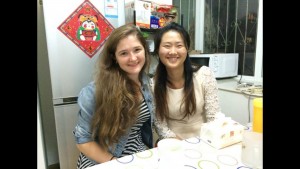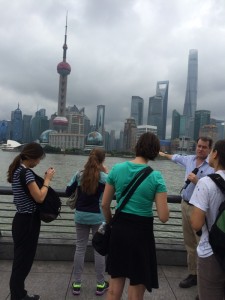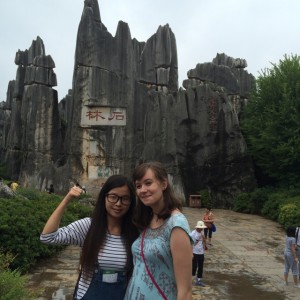We step out of the van into the dark corner of land that lies under a freeway overpass. Jia laoshi and Dan quickly confirm that yes, this is the trail to the dragon gate. A small path, which must have once been mostly stone, but is now mostly earth, ascends to the greenery growing on the side of the overpass. A few vendors have set up their stalls here, which is a good sign-this place isn’t completely abandoned.
In the greenery the trail changes dramatically- here the maintenance of the stone stairs has been much better. We begin to encounter other visitors. As we climb,we continue to see people selling trinkets and snacks- the constant presence of unofficial vendors, regardless of location, is a stark difference between the US and China. Their presence is not unwelcome- water is cheap and heavy, and it’s much more convenient to just purchase some when you’re running low, than carry a full day’s supply.
 At times, the path narrows to the point where even two people can’t walk abreast. I’m glad I’m not descending, since the path is steep and at times only the side furthest from the mountain has a handrail. Continuing in the face of these obstacles requires a certain assertiveness. I make the mistake of waiting for the stream of people to die down, and I don’t move for five minutes. I discover when I enter the stream, people make space for me and occasionally wait for me to pass. Drivers in China don’t hold the formal rules of the road to as high a regard as we do in the US. Rather, as long as something is not aggressive and dangerous, people will work with it. I think drivers are much more aware of the road here, and the same is true for foot traffic.
At times, the path narrows to the point where even two people can’t walk abreast. I’m glad I’m not descending, since the path is steep and at times only the side furthest from the mountain has a handrail. Continuing in the face of these obstacles requires a certain assertiveness. I make the mistake of waiting for the stream of people to die down, and I don’t move for five minutes. I discover when I enter the stream, people make space for me and occasionally wait for me to pass. Drivers in China don’t hold the formal rules of the road to as high a regard as we do in the US. Rather, as long as something is not aggressive and dangerous, people will work with it. I think drivers are much more aware of the road here, and the same is true for foot traffic.
Later in the day, we reach a point between several peaks. We’ve been ascending so long,and we’re so damn close. The trail doesn’t take us to any of them, so we decide to leave the trail. As we scramble over rocks, the evidence of human presence is notable- trash can be found caught between stones, and the top of boulders are red with dirt that could have only been carried by human feet. I have mixed feelings about this. On one hand, This is evidence that going off trail is not as taboo as it would be in other areas, which is comforting. However, it’s obvious that our presence is not beneficial to the wildlife. How many people justify leaving the trail because others do so? The problem of humanity coexisting with nature seems especially relevant here. I ponder these questions as we return to the trail and begin our descent.





